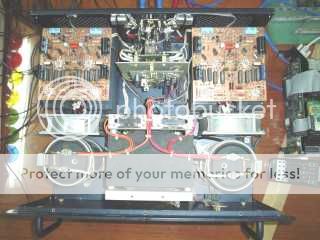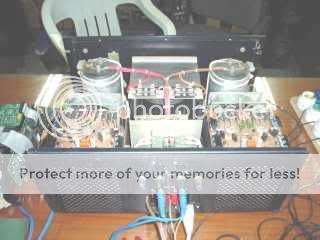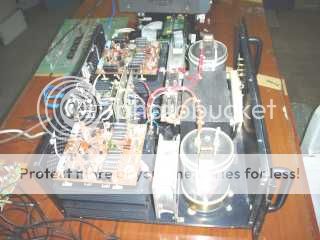I have an idea. Let us all design in an interactive “democratic” way the amplifier, which is according to most of us the best to build nowadays. So, I want to start a discussion by which, step by step, the design of a solid state home audio amplifier will grow. This process will be formed by questions to be discussed and answered by yes or no. Most votes after some days give the direction to go.
It is up to you to determine what is the definition of the “best”: minimum harmonic distortion or sound quality or ……….So this definition will stay out of the voting.
I recognize that most questions will not be independent of each other. Let that be so. We will go from to broad to narrow. Some assumptions I will make in advance. The amplifier, to be designed, must be solid state (so no tubes), analog (so not switching), home (so not for a concert hall) audio amplifier. These are the first questions I have in mind:
First question: must it be a feedback amplifier or not. To be exactly, I mean an overall feedback or a feedback over the first input+VAS stage or the output stage. I do not mean the use of emitter degeneration or the use of a CFP/Sziklai pair. And I do not mean the use of feedforward technique. These questions will follow later.
Second question: must it be a class A or a class AB/B amplifier?
Third question: must the amplifier be fully symmetrical (the “positive” and the “negative” side)?
And so on, and so on.
May I invite you to participate on this discussion? So let us start with the first very important question: must it be a feedback amplifier or not? (see above) After giving your opinion, I hope you will vote yes or no. We end this discussion at next Sunday 13 of June at 12.00 am GT and count then for the direction to go.
Marc.
It is up to you to determine what is the definition of the “best”: minimum harmonic distortion or sound quality or ……….So this definition will stay out of the voting.
I recognize that most questions will not be independent of each other. Let that be so. We will go from to broad to narrow. Some assumptions I will make in advance. The amplifier, to be designed, must be solid state (so no tubes), analog (so not switching), home (so not for a concert hall) audio amplifier. These are the first questions I have in mind:
First question: must it be a feedback amplifier or not. To be exactly, I mean an overall feedback or a feedback over the first input+VAS stage or the output stage. I do not mean the use of emitter degeneration or the use of a CFP/Sziklai pair. And I do not mean the use of feedforward technique. These questions will follow later.
Second question: must it be a class A or a class AB/B amplifier?
Third question: must the amplifier be fully symmetrical (the “positive” and the “negative” side)?
And so on, and so on.
May I invite you to participate on this discussion? So let us start with the first very important question: must it be a feedback amplifier or not? (see above) After giving your opinion, I hope you will vote yes or no. We end this discussion at next Sunday 13 of June at 12.00 am GT and count then for the direction to go.
Marc.
MARK VI, i expect you will ponderate those votes
Not i vote for me and i vote for Steven.... reading his background and hearing his words, i can strongly feel that his vote is more valuable than mine.
This way, i suggest you, to ponderate when give us results, and tell us the ponderation, what the values you gave.
Beginner
Skilled
HY Skilled and field proven guy
Those may have, in my idea, different ponderation weigths and values. My vote, cannot be same as Steven!
His volte, my idea, has at least, minimum, 3 times better and more precise than mine, in a objective way.... subjectivity can not ponderate, only God (if really exists) can do such a thing.
So, please, when finished, and i wish it make alive for long time, and people cooperate to see "forum idea", not my or his or someone else idea.
When Steven, and some other speak, i can hear deep knowledge, enormous experience, reading his profile you can have an idea what i am talking about. His words, Pass Words, Hugh Words, Rodd's Words, i think Curl words and so many, i prefer not to close with only those written above, because they are really more than those in numbers..... those men, when open the mouth, or put letters together, have deepness and when my brain hear, it have some Eco.... have more strengh.
This way...if you will be Democratic (please not alike Bush), and count a man equal a vote, please, inform also, the skilled man voltes in separate.
To the Cesar what belongs to the Cesar, to the people what belongs to the people.
Please, do it for me, if not for all, i want to know,... use direct mail for me please, if your decision is one man equal one vote:
nanabrother@yahoo.com
I do not think Steven is a better man than i am, do not think he is God, not those stupid things.... he is skilled man, can not compare as me in voltes related such a thing.
Mr Steven, do not need to be bother or have the idea to say thanks.... i am not doing that for you.... i want more precise result.
Carlos
Not i vote for me and i vote for Steven.... reading his background and hearing his words, i can strongly feel that his vote is more valuable than mine.
This way, i suggest you, to ponderate when give us results, and tell us the ponderation, what the values you gave.
Beginner
Skilled
HY Skilled and field proven guy
Those may have, in my idea, different ponderation weigths and values. My vote, cannot be same as Steven!
His volte, my idea, has at least, minimum, 3 times better and more precise than mine, in a objective way.... subjectivity can not ponderate, only God (if really exists) can do such a thing.
So, please, when finished, and i wish it make alive for long time, and people cooperate to see "forum idea", not my or his or someone else idea.
When Steven, and some other speak, i can hear deep knowledge, enormous experience, reading his profile you can have an idea what i am talking about. His words, Pass Words, Hugh Words, Rodd's Words, i think Curl words and so many, i prefer not to close with only those written above, because they are really more than those in numbers..... those men, when open the mouth, or put letters together, have deepness and when my brain hear, it have some Eco.... have more strengh.
This way...if you will be Democratic (please not alike Bush), and count a man equal a vote, please, inform also, the skilled man voltes in separate.
To the Cesar what belongs to the Cesar, to the people what belongs to the people.
Please, do it for me, if not for all, i want to know,... use direct mail for me please, if your decision is one man equal one vote:
nanabrother@yahoo.com
I do not think Steven is a better man than i am, do not think he is God, not those stupid things.... he is skilled man, can not compare as me in voltes related such a thing.
Mr Steven, do not need to be bother or have the idea to say thanks.... i am not doing that for you.... i want more precise result.
Carlos
For ultimate sound:
global feedback (no semiconductor is linear)
bipolar (gm, capacitance)
class AB (allows fewer, higher performance components)
asymmetrical (because electricity is)
For best sound vs ease of design:
no (low) global feedback
FET
class A
asymmetrical
But I'd say the place to start is not with the implementation detail but with the evaluation process. How will the design and design modifications be evaluated?
BAM
("HY skilled" on Destroyer's scale)
global feedback (no semiconductor is linear)
bipolar (gm, capacitance)
class AB (allows fewer, higher performance components)
asymmetrical (because electricity is)
For best sound vs ease of design:
no (low) global feedback
FET
class A
asymmetrical
But I'd say the place to start is not with the implementation detail but with the evaluation process. How will the design and design modifications be evaluated?
BAM
("HY skilled" on Destroyer's scale)
As ever having an unqualified "best / ultimate" discussion is pointless.
Its not hard to guess the results :
No feedback.
Class A.
Fully symmetrical.
FET's.
Regulated supplies.
None of the above are necessary for a very good amplifier,
and I wouldn't use any of them for a reasonably powerful
very good cost effective amplifier.
 sreten.
sreten.
Its not hard to guess the results :
No feedback.
Class A.
Fully symmetrical.
FET's.
Regulated supplies.
None of the above are necessary for a very good amplifier,
and I wouldn't use any of them for a reasonably powerful
very good cost effective amplifier.
Stefano said:How many watts do you think would make an universal power amp? 30? 50? 100? 250? It may determine some of the ways to do it...
I deliberately left that out, as there no such thing as an universal amplifier.
Or an universal load driving capabillty for the "universal" amplifier.
Class- A / AB
Not symmetrical
Low or no global feedback
High gain BJT's
Regulation for input and VAS only. RAW PSU for OP stage, with lots of low ESR caps and high rails.
(By the way, personally I would Bi-amp with the Bass amp having heavy feedback/ Bipolar/ class-B OP stage. For the HF amp, the one I described above is ok.)
K-
Not symmetrical
Low or no global feedback
High gain BJT's
Regulation for input and VAS only. RAW PSU for OP stage, with lots of low ESR caps and high rails.
(By the way, personally I would Bi-amp with the Bass amp having heavy feedback/ Bipolar/ class-B OP stage. For the HF amp, the one I described above is ok.)
K-
My vote:
No global feedback
bridge with single power supply
degenerated differential input with MOSFET/BJT Sziklay pairs
MOSFET output stage with active current sources
cheap vertical MOSFETs
therefore pure class A
output stage error correction
short signal path (not more than 3 active devices)
input pot for being driven directly from CD player
Cheers,
Gerhard
No global feedback
bridge with single power supply
degenerated differential input with MOSFET/BJT Sziklay pairs
MOSFET output stage with active current sources
cheap vertical MOSFETs
therefore pure class A
output stage error correction
short signal path (not more than 3 active devices)
input pot for being driven directly from CD player
Cheers,
Gerhard
Suppose you have a circuit with an instantaneous non-linear input to output transfer which can be expressed with the following Taylor series:
f(x)=a0+a1*x+a2*x^2+a3*x^3+a4*x^4+a5*x^5+...
If you make a balanced version by taking two of these circuits, giving them equal but opposite input signals, and subtracting the output signals, the result is:
f(x)-f(-x)=2*a1*x+2*a3*x^3+2*a5*x^5+...
In this case, all even-order terms are gone, but the odd-order terms have doubled. As this also applies to the linear term (2*a1*x versus a1*x), the odd-order distortion stays the same. I guess this is what happens in the fully complementary designs.
However, if you divide the input signal between the two circuits, the result is:
f(x/2)-f(-x/2)=a1*x+(1/4)*a3*x^3+(1/16)*a5*x^5+...
- Status
- This old topic is closed. If you want to reopen this topic, contact a moderator using the "Report Post" button.
- Home
- Amplifiers
- Solid State
- Designing the best solid state analog home audio amplifier ever (self) build.




